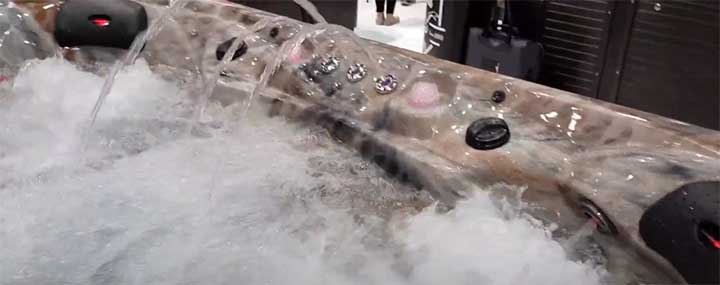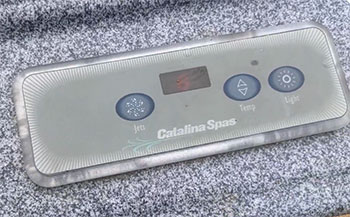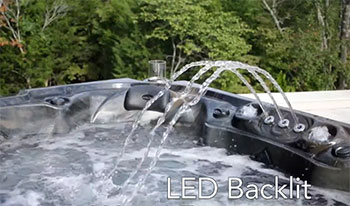Catalina spas promise a relaxing hot tub experience right in your own backyard. But like any major appliance, issues can pop up that turn your personal oasis into a headache. As a long-time Catalina spa owner myself, I’ve run into my fair share of problems over the years.
In this guide, I’ll walk through the most common Catalina spa complaints I’ve encountered, provide troubleshooting tips, and share advice on how to keep your hot tub running smoothly for years to come.
Common Problems With Catalina Spas
Here is a list of those issues:
- Widespread Leaks Causing Daily Top-Offs
- Mold and Mildew Buildup
- Persistent “Heater High Limit” Error Messages
- Noisy, Grinding Pump Motors
- Cloudy, Hazy Water Even After Shocking
- Pump Motors Turning On and Off Repeatedly
- Topside Control Panel Freezes Up
- “LF” or Flashing LEDs on Topside Panel
- Excessive Energy Usage Spikes on Electric Bill
Let’s talk about those problems in detail.
Widespread Leaks Causing Daily Top-Offs

One of the most frustrating problems with Catalina spas is water leaks. You get into your spa expecting a soothing soak only to find the water level lower than before. A leak can occur for several reasons:
- Faulty Plumbing Connections
If your spa has any below-the-water-line plumbing connections, these can loosen over time and start dripping. Check any unions or gaskets and tighten or re-seal them to stop minor leaks.
- Cracked Shell
Catalina acrylic spa shells are durable but not indestructible. Prolonged exposure to sun and harsh cleaners can cause cracks to form, allowing water to seep out. Try a special acrylic crack repair kit for temporary fixes, but full shell replacement may ultimately be needed.
- Worn Pump Seals
The seals around spa pump shafts tend to wear out every 3-5 years, allowing water to drip as the pumps run. Identify which pump is leaking, turn off power to the spa, and replace the rear seal to stop the leak.
I try to check my Catalina for any drips or damp spots around the equipment bay weekly to catch leaks right away before they become bigger issues. But even with diligent maintenance, leaks seem inevitable with older hot tubs.
Mold and Mildew Buildup
Sitting water combined with jets shooting out warm vapor make spa interiors prone to icky mold growth. Catalina spas seem especially susceptible due to their all-plastic construction and tightly sealed covers. Here’s how to combat mold and always keep your spa sparkling clean:
- Clean filters weekly: Mold feeds off dirt and debris caught in your filter cartridges. Stay on top of cleaning or replacing filters so jet flow isn’t obstructed.
- Clean covers and shells monthly: Use non-abrasive spa surface cleaner to scrub off any film or discoloration monthly. Rinse and dry covers fully after use.
- Shock weekly: “Shocking” the water with sanitizer (like chlorine or bromine) kills mold and biofilm buildup. Stick to a routine shock treatment schedule.
- Replace water regularly: Drain and refill your Catalina every 3-4 months to wash away any stubborn mold in pipes.
Following these mold prevention steps takes vigilance but pays off in clean, healthy spa water. Consider installing an ozone purification system as well for further mold protection.
Persistent “Heater High Limit” Error Messages
Seeing a “heater high limit” error pop up on your spa’s control panel? This usually indicates the high limit sensor was tripped because the heater overheated, likely due to low water flow. Here are some troubleshooting tips:

- Check and clear filters: Dirty filters restrict water flow, causing the heater to overwork. Clean or replace filters to restore proper flow.
- Test blower and pressure switch: Insufficient air bubbles can also trigger the high limit sensor. Ensure blower is running and pressure switch isn’t obstructed.
- Check for air locks: Air trapped in plumbing will cause low flow. Bleed air by loosening pump unions and let water stream out.
- Test voltage: High or low voltage can damage the heater. Have an electrician check voltage is within 10% of 240V.
If airflow and plumbing issues are ruled out, the internal high limit might need replacement by a spa technician. But trying these steps first often resolves common heater limit problems.
Noisy, Grinding Pump Motors
Nothing ruins a tranquil spa session like loud pumps droning on in the background. Catalina spa pumps contain bearings and seals that wear out over years of use. Here are warning signs of pumps on their last legs:
- High-pitched squealing: Bearings might be dry and need lubrication to stop squealing noises.
- Humming/vibrating: Excess vibration indicates bearings are worn and ready for replacement.
- Leaking: Weep holes around pump seal could indicate seal needs replacement.
- Overheating: Failing pump motor may overheat and trip GFCI breaker.
Catch failing pumps early before bearings totally seize up and burn out motor windings. Unfortunately, rebuilding these 2-speed wet end pumps is not cost effective. Complete new pump replacement is the fix once bearings are shot. Annoying pump noise should not be tolerated in your soothing spa sanctuary!
Cloudy, Hazy Water Even After Shocking
No matter how often you shock your Catalina, the water just never stays crystal clear for long. Cloudy, foamy water is probably the most common spa problem I hear. Here are some likely trouble causes and solutions:
- Not Enough Sanitizer: Test chlorine/bromine levels with test strips. Maintain 2-4 ppm. Shock weekly and run jets to circulate sanitizer.
- High pH: High pH above 7.8 reduces sanitizer effectiveness. Test and adjust pH down to 7.2-7.6.
- High Alkalinity: Alkalinity above 150 ppm makes water resistant to change. Target 80-120 ppm.
- High Calcium: Hard water causes scale buildup that clouds water. Add stain & scale preventer.
- Dirty Filters: Clogged filters prevent proper water circulation and sanitization. Clean or replace monthly.
- Too Many Bathers: Frequent heavy bather loads strain filtering system. Limit soak time and bather frequency.
- Biofilm Buildup: Stubborn cloudiness may indicate biofilm needs removal with a water clarifier.
Be diligent about regularly testing and balancing all water chemistry levels. And don’t ignore cloudy water hoping it will fix itself – take action quickly for clear spa satisfaction.
Pump Motors Turning On and Off Repeatedly
Pump motors frequently turning on and off when you’re not using the spa points to an electrical issue brewing. Here are a few things that could cause cycling pump behavior:

- Bad GFCI Breaker: A failing GFCI will trip repeatedly and reset pump power. Replace breaker if it’s older than 5 years.
- Loose Wiring: Check spa side wiring connections are tight. Loose wires can briefly cut power.
- Bad Heating Element: If only pump 1 cycles on/off, the heater element might be malfunctioning. Contact technician for heater replacement.
- Corroded Contacts: Green corrosion on circuit board contacts interrupts power. Sand off corrosion or replace circuit board.
- Insufficient Power: If your spa is on a shared circuit, insufficient power may cause cycling. Have electrician install dedicated line.
Sudden, frequent pump cycling usually indicates an underlying electrical fault. Be proactive at the first sign of trouble to avoid complete pump burnout down the road.
Topside Control Panel Freezes Up
Few things are more annoying than when you get in your spa to relax only to find the topside controls completely frozen and unresponsive. Catalina panels seem particularly prone to locking up and requiring power cycling. Here are some troubleshooting tips for a frozen panel:
- Hold down all buttons at once to force panel to reset
- Unplug the spa for 1 minute to reboot the system
- Check for condensation or water damage behind panel
- Ensure panel cable connections are dry and intact
- Try disconnecting accessory panels like WiFi modules
- Replace fuse on circuit board if blown
- Update control panel software if out of date
- Replace control panel if above steps don’t resolve issue
Avoid harshly tapping on frozen panels which could further damage delicate components. With some power cycling and wire checking, hopefully you can get your unresponsive panel operational again without replacement. But have a tech inspect wiring for any corrosion issues.
Solving Cloudy Spa Water Issues
Unfortunately cloudy, hazy spa water is an inevitable issue over time. As you soak in your Catalina hot tub, residue from your body, bathing suits, and chemicals gradually contaminates the water. While proper sanitization prevents dangerous microbes, cloudiness still develops.
Thankfully crystal clear spa water is achievable with the right troubleshooting approach. Here are handy tips for combating cloudiness causes:
Shock Treatment – Shocking with sanitizer eliminates contaminants. Pour directly into water per product instructions.
Clean or Replace Filter – Filthy filters allow particles through. Regularly clean filter cartridges to restore flow.
pH Balance – Improperly balanced alkalinity and pH leads to cloudiness. Test and restore proper levels.
Water Change – If cloudiness persists, drain a portion of spa water and refill to dilute contamination.
With frequent shocking, new soak-away filters, balanced water, and partial water swaps, your Catalina spa water should stay crisp and clear for months at a time.
Stopping Leaks from Jets and Plumbing
Water leaking from the jets, pipes, or any spa fitting creates a huge headache. Left unfixed, leaks can damage spa components and your backyard. Catalina spas use a complex system of gaskets, seals, and connection points that can work loose or fail as seals degrade over time.

To stop a leak in your Catalina hot tub:
Identify Source – Locate the exact jet, pipe or fitting leaking. Run the pumps to build pressure and check. May require complete water drain.
Tighten Fittings – Carefully tighten any loose unions, couplings or joints around leaking areas with pliers and Teflon tape. Don’t overtighten.
Replace Damaged Parts – Any cracked or failing gaskets, O-rings, seals should be replaced with identical Catalina parts to create a tight seal.
Double Check Repairs – Refill spa, run pumps and jets to pressurize system and verify leak is fully resolved before returning to use.
Don’t ignore even small leaks – over time expansion and pressures can worsen the issue. Get leaking fixed right away before major spa components are damaged.
No or Low Heat Issues
What good is a hot tub without the hot? Lack of heat takes the enjoyment out of your spa and usually indicates a malfunction.
Catalina spas rely on a powerful heater and integrated hydrotherapy pump system to heat water up to 104°F. When spa heat fails, a few key parts may be the culprit. Try these troubleshooting tips:
Set Temperature – Ensure your desired heat level is programmed correctly and the spa is set to heat mode. Rule out user error.
Check Error Code – Most Catalina spas flash a trouble code on the topside control panel pointing to the heat problem cause.
Reset GFCI Breaker – If the high-amp GFCI breaker on your spa has tripped, resetting it may restore heating functionality.
Replace Heating Element – Burnt out or failing electric heating elements must be replaced to restore hot water capacity.
Repair Circulation Pump – The circulation pump moves water past the heating element. Pump failure causes cold spa water.
Don’t hesitate to contact Catalina customer support – their experts can walk you through proper heating system repairs and parts replacement. Hot water is a must!
“LF” or Flashing LEDs on Topside Panel
Seeing cryptic error codes like “LF” accompanied by flashing LED lights on your Catalina panel? This indicates a hardware failure in the spa triggering an error message. Specifically:
- “LF” error – Low Flow switch activated. Pump may have airlock, blockage, or be malfunctioning.
- Flashing Heater LED – Heater high limit was triggered. Low water flow or dirty filter likely.
- Flashing Temp LEDs – Sensors detected 118°F and spa is in high-temperature protection mode.
Don’t ignore these basic error codes! The problems will only escalate if left unchecked. Inspect affected components like pumps, filters, and sensors thoroughly. Reset the system and monitor for proper heating/circulation function. Call technician if error persists.
Excessive Energy Usage Spikes on Electric Bill
Seeing power bills skyrocket after installing your Catalina spa? No one wants sticker shock when trying to unwind in their spa. Excess kilowatt usage usually stems from one of these issues:
- Running Filtration Too Long: Limit filtration cycles to 4-6 hours max daily. Use low-speed pumps for filtration to conserve power.
- High Set Temp: Heater works harder maintaining higher water temps. Lower set temp to 98-100°F.
- Dirty Filter: Clogged filters make pumps work harder and run longer. Maintain clean filters.
- Large Hot Tub: Bigger water capacity takes more power to heat. Limit soak time in larger spas.
- Damaged Heater: A malfunctioning heater can draw excess power. Have technician test element.
- Improper Wiring: Incorrect electrical install can overload circuits. Hire electrician to validate wiring.
Monitor electric bills for 2-3 cycles after install to establish normal usage. Compare costs of operating pumps on low versus high speed. A timer can also help limit total pump run time and save hundreds per year.
Additional Troubleshooting Tips
Here are a few other quick troubleshooting tips for common Catalina spa headaches:
- Ozone smell – Excess ozone indicates a malfunctioning ozonator. Remove and replace ozonator.
- No heat – Check set temperature is higher than actual water temperature. Call technician if heater issue.
- Pump surges – Loose wiring can cause power spikes. Inspect wiring connections.
- Blown fuses – Replace fuses with proper amperage ratings. Identify root cause of shorts/overloads.
- Leaking plumbing – Tighten all unions and fittings. Replace cracked PVC pipes.
- Musty covers – Clean and disinfect covers regularly. Consider non-PVC cover material.
Frequently Asked Questions (FAQ)
With proper care and maintenance, most Catalina spa components should last approximately:
1. Acrylic shell: 10-15 years
2. Pumps/motors: 5-8 years
3. Plumbing parts: 5-10 years
4. Circuit boards: 4-6 years
5. Filter cartridges: 2 years
6. Cover: 5-8 years
7. Heater element: 5-10 years
Catalina quality has declined in recent years, so lifespan may be less compared to older models. Follow preventative maintenance tips to maximize your spa’s longevity.
Catalina used to be known for better quality and value in the mid-range hot tub market. But quality issues have emerged in recent years even though prices remain relatively high. Frequent pump, leak, and electrical problems now plague many newer Catalina spas. Unless buying an older, used Catalina in good condition, you may want to consider other brands.
The most prevalent hot tub problem owners face is maintaining clean, clear water. Chemical imbalances and dirty filters probably cause 80% of hot tub headaches. Staying on top of regular sanitizing, shocking, balancing pH/alkalinity, and filter cleaning will prevent many issues.
On Catalina topside panels, SL refers to Sleep Mode. This low-power filtration mode runs the pump on low speed for clean-up cycles overnight or while away. Use SL mode to save energy and filter time versus high-speed Normal Mode when tub is not occupied.
To reset a Catalina spa, locate the GFCI breaker supplying power to the spa and turn it fully OFF and then back ON. This will reset the spa’s systems and often clear error codes. You can also try pressing the Reset button on the control panel.
Start by checking error codes on the control panel display. Refer to Catalina’s code chart to identify issues. Inspect jets, filters, and pumps for debris, damage, or leaks. Check insulation under shell. Test GFCI breaker and all equipment. Measure chemical and pH levels.
Final Thoughts
Catalina spas promise an at-home oasis but also come with their share of troubles if maintenance is skipped. Stay ahead of problems by following the tips outlined here before small issues mushroom into major headaches (and expensive repairs).
With consistent care, your Catalina can remain a reliable source of relaxation for many years rather than a stress point.
Happy hot tubbing!
